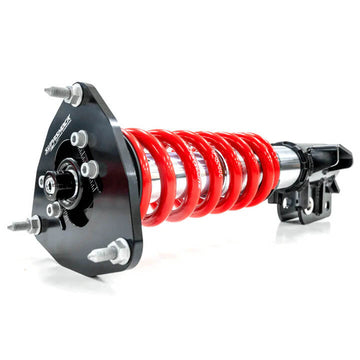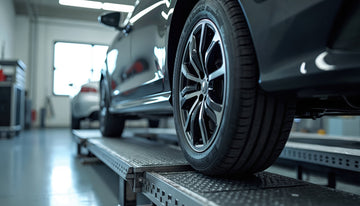Compression damping and rebound damping are terms used to describe the characteristics of a suspension system in cars, specifically related to the behaviour of the shocks or dampers.
Compression damping
Compression damping refers to the resistance provided by the shock absorbers to the compression or upward movement of the suspension when encountering bumps or uneven surfaces. When a car's wheel encounters an obstacle, the suspension compresses, and the compression damping helps control the speed at which the suspension compresses.
It works by using hydraulic resistance to slow down the compression, preventing the suspension from rapidly bottoming out or bouncing excessively. Compression damping plays a crucial role in maintaining tire contact with the road surface, ensuring stability, and preventing excessive body roll and oscillation.
What is the difference between high speed and low speed compression damping?
High-speed and low-speed compression damping refer to the two separate adjustments available on some adjustable shock absorbers or dampers. These adjustments allow for fine-tuning the damping characteristics of the suspension system based on different speed ranges of suspension movement.
High-speed compression damping primarily controls the damping force during sudden and fast suspension movements. It is responsible for managing the compression speed of the suspension during aggressive manoeuvres, such as hitting a large bump or landing from a jump. High-speed compression damping helps prevent the suspension from bottoming out too quickly or excessively, reducing the risk of damage and maintaining better control of the vehicle.
Low-speed compression damping, on the other hand, focuses on regulating the damping force during slower suspension movements. It primarily affects the vehicle's behaviour during normal driving conditions, such as cornering, braking, and accelerating. Low-speed compression damping helps control the weight transfer of the vehicle, minimising body roll, and improving overall stability.
Rebound damping
Rebound damping, on the other hand, refers to the resistance offered by the shock absorbers to the rebound or downward movement of the suspension after it has been compressed. When the suspension compresses, it subsequently rebounds back to its normal position as the spring pushes the wheel and un-sprung weight of the vehicle away from the vehicle's body.
It controls the speed at which the suspension extends or rebounds, helping to manage the energy stored during compression and preventing the suspension from oscillating uncontrollably. It ensures that the suspension returns to its resting position smoothly and progressively, improving the car's overall handling, comfort, and tire traction.
What are the benefits of compression damping?
Compression damping in a car's suspension system provides several benefits, including:
Improved stability
Compression damping helps maintain stability by controlling the rate at which the suspension compresses. It prevents the suspension from bottoming out too quickly, ensuring that the tires maintain contact with the road surface. This stability enhances vehicle control, especially during aggressive manoeuvres or when encountering uneven or bumpy surfaces.
Enhanced handling
By regulating the compression speed of the suspension, compression damping contributes to improved handling characteristics. It helps to minimise body roll, pitch, and dive, allowing the car to stay more balanced and controlled during cornering, braking, and acceleration. This results in better overall grip, responsiveness, and precision while manoeuvring.
Reduced body oscillations
Compression damping prevents excessive suspension oscillations by slowing down the compression movement. This reduces the tendency for the car's body to bounce or float excessively after encountering bumps or undulations in the road. By dampening these oscillations, compression damping improves overall ride comfort and reduces driver and passenger fatigue.
Tire traction optimisation
Effective compression damping ensures that the tires remain in contact with the road surface as much as possible. This maximises tire traction and grip, improving both the vehicle's acceleration and braking capabilities. It helps prevent wheel hop or tire skipping, providing better control and reducing the risk of traction loss during dynamic driving situations.
Protection from damage
Compression damping helps protect the suspension components from damage caused by sudden impacts or large bumps. By slowing down the compression movement, it prevents the suspension from excessively bottoming out, reducing the risk of damaging the shocks, springs, or other suspension parts. This prolongs the lifespan of the suspension system and contributes to overall durability.
How can I maintain damping performance in my vehicle?
To maintain the damping performance in your vehicle, here are some key steps you can take:
Regular inspections
Schedule regular inspections of your suspension system by a qualified mechanic or technician. They can inspect the shocks or dampers for any signs of leaks, physical damage, or excessive wear. Catching and addressing any issues early on can help maintain optimal damping performance.
Follow manufacturer's recommendations
Adhere to the maintenance schedule and recommendations provided by the vehicle manufacturer. This includes specific guidelines for servicing the suspension system. Following these recommendations ensures that the damping components are checked, adjusted, or replaced at the appropriate intervals.
Replace worn dampers
If your vehicle's dampers show signs of significant wear, reduced performance, or are past their recommended service life, consider replacing them. Worn dampers may lose their ability to effectively control the suspension movement, compromising stability, handling, and comfort.
Maintain proper tire pressure
Ensure that your vehicle's tires are inflated to the manufacturer's recommended pressure levels. Proper tire pressure helps optimise the interaction between the suspension and the tires, allowing the dampers to function optimally.
Avoid overloading
Avoid exceeding the maximum weight capacity recommended for your vehicle. Overloading can put excessive stress on the suspension system, including the dampers, leading to decreased damping performance over time.
Adjust damping settings
If your vehicle has adjustable damping settings, such as adjustable shocks or electronic suspension control, familiarise yourself with the manufacturer's recommendations and adjust the settings according to your preferences or specific driving conditions. This allows you to fine-tune the damping characteristics for optimal performance.
Choosing the Right Suspension Setup
When it comes to selecting the right suspension setup for your vehicle, understanding suspension damping and its adjustment is crucial. Suspension damping refers to the resistance offered by shock absorbers to compression and rebound movements of the suspension. By fine-tuning compression and rebound damping, you can optimise the performance and handling of your vehicle.
Compression damping plays a vital role in maintaining stability, enhancing handling, reducing body oscillations, optimising tire traction, and protecting suspension components. It controls the rate of compression, ensuring tire contact with the road surface, improved vehicle control, and minimised body roll during aggressive manoeuvres or encounters with uneven terrain.
Differentiating between high-speed and low-speed compression damping is essential. High-speed compression damping manages sudden and fast suspension movements, such as large bumps or jumps, preventing excessive bottoming out and maintaining vehicle control. Low-speed compression damping focuses on regulating slower suspension movements during regular driving conditions, improving stability and weight transfer.
Rebound damping, on the other hand, controls the speed at which the suspension extends or rebounds, preventing uncontrollable oscillations and ensuring smooth handling, comfort, and tire traction.





